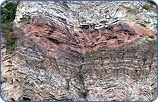 |
The geography of the Danube river basin is very diverse. It includes high mountain chains, large plains, sand dunes, large forested or marshy wetlands and, very specifically, the karst and the delta. Similarly, climate and precipitation vary significantly; and they continuously form the basin's landscapes. Generally, the Danube basin is dominated by a continental climate (central and eastern regions). Only the western parts of the upper basin in Germany are influenced by the Atlantic climate and the south-west of the basin (ex-Yugoslavian countries) by the Mediterranean climate. The Alps in the west, the Dinaric-Balkan mountain chains in the south and the Carpathian mountain bow in the eastern center are distinctive morphological and climatic regions and barriers. These mountain chains receive the highest annual precipitation (1,000-3,200 mm per year) while the inner and outer basins (Vienna basin, Pannonian basin, Romanian and Prut low plains), the lowlands of the Czech Morava and the delta region are very dry (350-600 mm per year). The rivers with their water and moisture from the wet mountains help to balance evapotranspiration deficits, typical for the Pannonian plain and the delta, in the dry lowlands. 50 to 70 days of annual snowfall are recorded at high elevations in the Alps and in the Carpathians, while the plains have just 1-3 days/year of snowfall. In terms of geomorphology and annual precipitation, 45 regions in the Danube basin can be distinguished, as presented in map 1 ("Geographical Indicators"). |
|
|
After the source of the Danube in the wet Black Forest, rainfall gradually increases from the west to the east, along the Swabian & Frankonian Middle Mountains (average precipitation 600 - 700 mm/year), the Bavarian Forest & Austrian Mühlviertel (over 1,000 mm). There are 3 pre-alpine and 5 alpine regions, with top rainfalls reaching more than 2,000 mm/year at the Arlberg and the Kitzbühel and Julian Alps. Downstream the Wachau canyon (Bohemian mountains), the Danube enters the Vienna basin which is, together with the Moravian hills and lowlands, the driest area (below 600 mm/yr) of the Upper Danube. |
 |
The middle part or "heart" of the Danube Basin is a circle of mountain chains around the huge Pannonian plain in the center. It is composed of six regions including parts of Austria, Slovakia, Hungary, Romania, Croatia and Serbia&Montenegro. This inner basin is filled with Miocene marine sediments, tertiary clays and sands as well as with Pleistocene fluvio-glacial and loess deposits. This results in little variation in the orography (hilly lands and the Danube and Tisza low plains) and in precipitation (500-750 mm/year). The Carpathian mountains in the northern and the central-eastern parts of the Danube basin receive varying rainfall from 750 mm in the foothills to over 1,500 mm in the ridges, and have quite cold winters (average temperature in January -8 to -10° C). The ridges of the Tatra, the Wood Carpathians and the Southern Carpathians receive highest precipitation (over 2,000 mm/year around the highest peaks at over 2,500 m). The Transilvanian tableland is a dry upland (500-700 mm) in between the moist Apuseni mountains (over 1,000 mm) in the west and the Eastern and theSouthern Carpathians (upper reaches of Mures and Olt rivers). The Dinaric Mountains form the borderline of the south-eastern Danube basin which is under Mediterranean (southern Sava tributaries) and continental influence (Drava-Mura lowlands). Precipitation is over 1,000 mm along the Slovene-Croatian border, along the Bosnian mountain ridges and the Albanian Alps, and goes down below 700 mm in the Danube/Pannonian plains. The Southern Morava valley (Serbia/Kosovo) is a relatively dry, north-south directed barrier (average rainfall at 700 mm, evapotranspiration at 550 mm) between the Bosnian mountains and the Banat/Western Balkan mountains. |
|
|
The moist Balkan mountain ridges form the southern borderline of the lower Danube and supply water for the relatively hot and dry Bulgarian hills and lowlands. East of the Carpathians, the huge plain of the Romanian Lowlands and the Moldova hills are subject to a temperate-continental dry climate along the lower Danube resp. the Siret and Prut rivers. The lowlands around the Balta Danube, the Liman lakes and the Danube delta receive an annual precipitation of slightly less than 400mm/year. Frequent droughts and a very high evapotranspiration are balanced by riverine moisture (high groundwater, network of islands and lakes, floodplains). |






